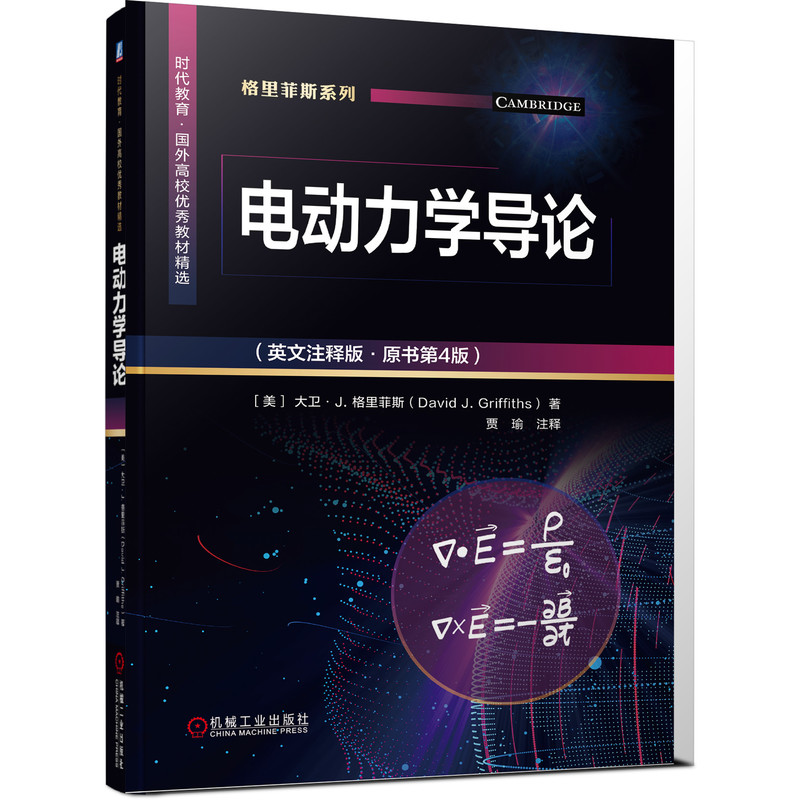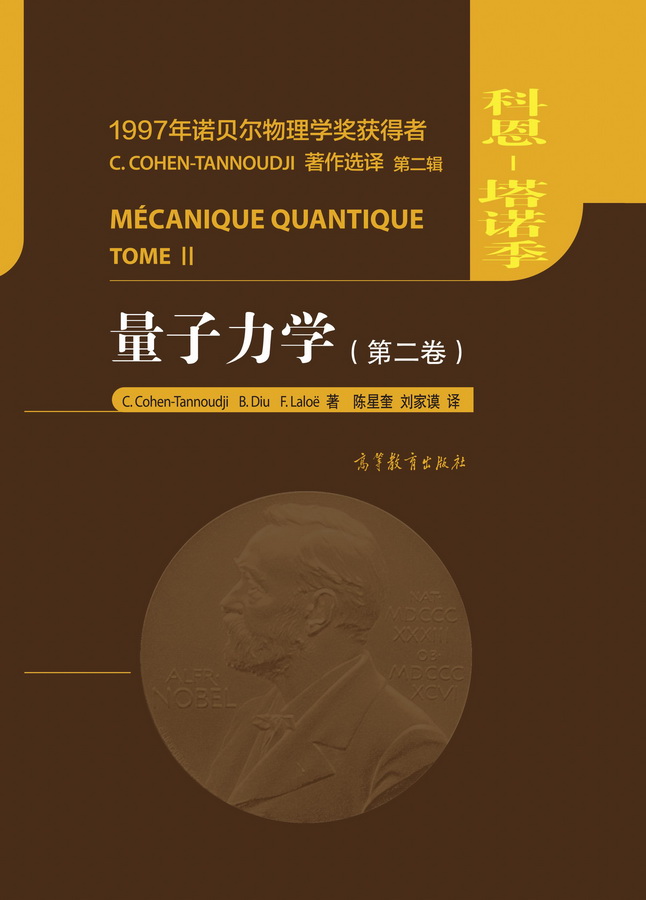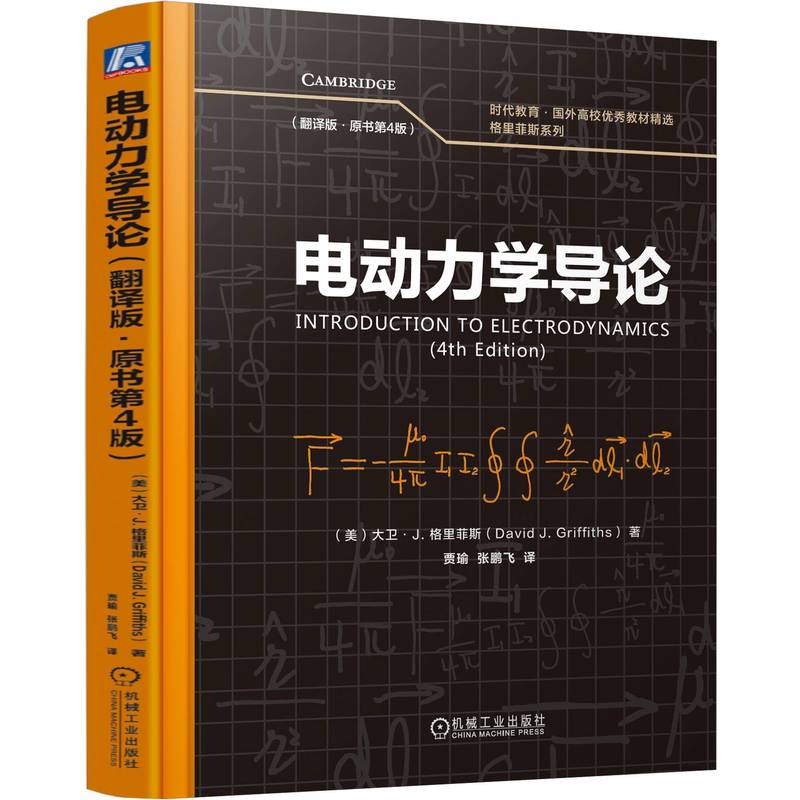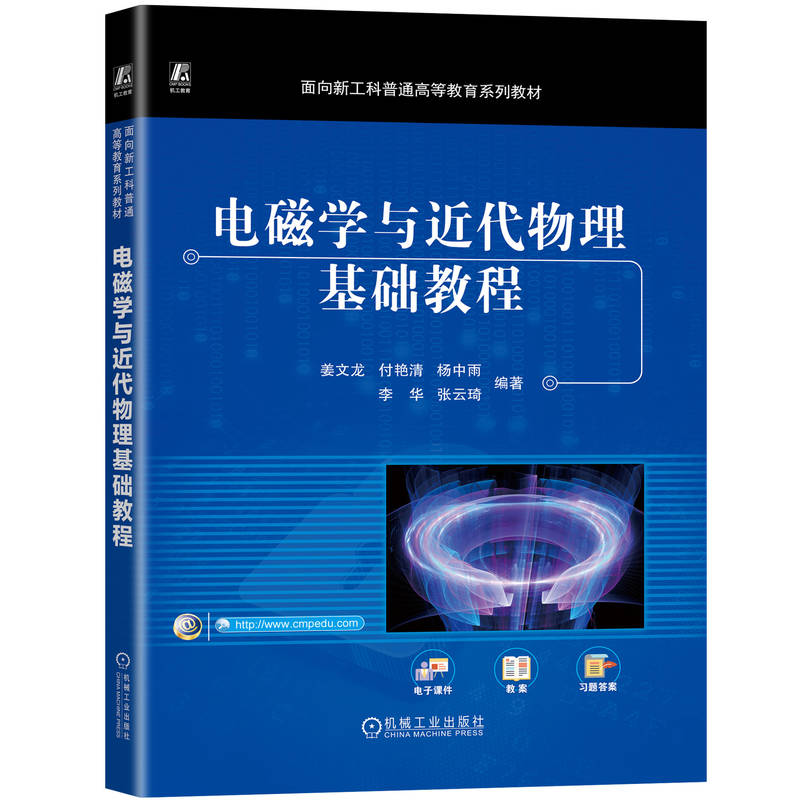电动力学导论(英文注释版·原书第4版) / 时代教育·国外高校优秀教材精选
定价:¥128.00
作者: [美]大卫·J.格里菲斯
出版时间:2021-07
最新印次日期:2024-7
出版社:机械工业出版社
试读
- 机械工业出版社
- 9787111678076
- 1-2
- 419695
- 48268083-2
- 平装
- 16开
- 2021-07
- 927
- 648
- 工学
- 力学类
- 工程力学
- 本科
内容简介
本书是一本立足本科生水平的电动力学教材,主要阐述电磁场理论,分析各个实验定律,从中总结出电磁场的普遍规律,建立麦克斯韦方程组和洛伦兹力公式,讨论恒定电磁场问题,说明一些恒定场的基本性质和求解电场和磁场问题的一些基本方法,讨论电磁波的传播与辐射,介绍一般情况下势的概念和辐射电磁场的计算方法,*后将电动力学的参考系引入相对论时空观,导出电磁场量在不同参考系间的变换,并且说明相对论力学的基本概念。本书注重把现代物理前沿引入教学,把电动力学问题扩展到多个前沿的研究领域,如固体物理、天体物理、核物理学、计算物理等。
本书涵盖我国物理专业电动力学课程的基本内容,可作为高等学校物理专业低年级学生学习电动力学课程的教材或参考书,也可作为电子、材料、通信等专业高年级学生的教学参考书。
This is a blingual edition of the following title published by Cambridge University Press:
Introduction to Electrodynamics,Fourth edition,ISBN 9781108420419
This book was previously published by Pearson Education,Inc. 1989, 1999, 2013
Reprinted 2018
Cambridge University Press and China Machine Press 2020.
This blingual of edition is authorized for sale in the People’s Republic of China (excluding Hong Kong, Macau and Taiwan) only. Unauthorised export of this blingual edition is a violation of the Copyright Act. No part of this publication may be reproduced or distributed by any means, or stored in a database or retrieval system, without the prior written permission of Cambridge University Press and China Machine Press.
本书由Cambridge University Press授权机械工业出版社在中国境内(不包括香港、澳门特别行政区及台湾地区)出版与发行。未经许可之出口,视为违反著作权法,将受法律之制裁。
Copies of this book sold without a Cambridge University Press sticker on the cover are unauthorized and illegal.
本书封面贴有Cambridge University Press防伪标签,无标签者不得销售。
北京市版权局著作权合同登记 图字:01-2019-7254号。
本书涵盖我国物理专业电动力学课程的基本内容,可作为高等学校物理专业低年级学生学习电动力学课程的教材或参考书,也可作为电子、材料、通信等专业高年级学生的教学参考书。
This is a blingual edition of the following title published by Cambridge University Press:
Introduction to Electrodynamics,Fourth edition,ISBN 9781108420419
This book was previously published by Pearson Education,Inc. 1989, 1999, 2013
Reprinted 2018
Cambridge University Press and China Machine Press 2020.
This blingual of edition is authorized for sale in the People’s Republic of China (excluding Hong Kong, Macau and Taiwan) only. Unauthorised export of this blingual edition is a violation of the Copyright Act. No part of this publication may be reproduced or distributed by any means, or stored in a database or retrieval system, without the prior written permission of Cambridge University Press and China Machine Press.
本书由Cambridge University Press授权机械工业出版社在中国境内(不包括香港、澳门特别行政区及台湾地区)出版与发行。未经许可之出口,视为违反著作权法,将受法律之制裁。
Copies of this book sold without a Cambridge University Press sticker on the cover are unauthorized and illegal.
本书封面贴有Cambridge University Press防伪标签,无标签者不得销售。
北京市版权局著作权合同登记 图字:01-2019-7254号。
目录
目 录
注释者序
前言
关于本书
导 读
第1章 矢量分析1
1.1 矢量代数 1
1.1.1 矢量操作 1
1.1.2 矢量代数:分量形式 4
1.1.3 三重积 7
1.1.4 位置、位移与分离矢量 8
1.1.5 矢量如何变换 10
1.2 微分运算 13
1.2.1 普通导数 13
1.2.2 梯度 13
1.2.3 Δ算符 16
1.2.4 散度 17
1.2.5 旋度 18
1.2.6 乘积规则 20
1.2.7 二阶导数 22
1.3 积分运算 24
1.3.1 线、面和体积分 24
1.3.2 微积分的基本定理 29
1.3.3 有关梯度的基本定理 29
1.3.4 有关散度的基本定理 31
1.3.5 有关旋度的基本定理 34
1.3.6 分部积分 36
1.4 曲线坐标系 38
1.4.1 球坐标系 38
1.4.2 柱坐标系 43
1.5 狄拉克δ函数 45
1.5.1 /r2的散度 45
1.5.2 一维狄拉克δ函数 46
1.5.3 三维δ函数 50
1.6 矢量场理论 52
1.6.1 亥姆霍兹定理 52
1.6.2 势函数 53
第1章补充习题 55
导 读
第2章 静电学59
2.1 电场 59
2.1.1 引言 59
2.1.2 库仑定律 60
2.1.3 电场 61
2.1.4 连续电荷分布 63
2.2 静电场的散度和旋度 66
2.2.1 电场线、电通量、高斯定律 66
2.2.2 E的散度 71
2.2.3 高斯定律的应用 71
2.2.4 E的旋度 77
2.3 电势 78
2.3.1 势的概念 78
2.3.2 有关势的评注 80
2.3.3 泊松方程与拉普拉斯方程 83
2.3.4 局域电荷分布的势 84
2.3.5 边界条件 88
2.4 静电场的能量与做功 91
2.4.1 移动电荷所需做的功 91
2.4.2 点电荷分布的能量 92
2.4.3 连续电荷分布的能量 94
2.4.4 有关静电场能量的评注 96
2.5 导体 97
2.5.1 基本性质 97
2.5.2 诱导电荷 99
2.5.3 表面电荷和导体受到的力 103
2.5.4 电容 105
第2章补充习题 108
导 读
第3章 势113
3.1 拉普拉斯方程 113
3.1.1 引言 113
3.1.2 一维拉普拉斯方程 114
3.1.3 二维拉普拉斯方程 115
3.1.4 三维拉普拉斯方程 117
3.1.5 边界条件和唯一性定理 119
3.1.6 导体和第二唯一性定理 121
3.2 镜像法 124
3.2.1 典型镜像问题 124
3.2.2 诱导表面电荷 125
3.2.3 力和能量 126
3.2.4 其他镜像问题 127
3.3 分离变量法 130
3.3.1 直角坐标 131
3.3.2 球坐标 141
3.4 多极矩展开 151
3.4.1 远距离处的近似势 151
3.4.2 单极与偶极项 154
3.4.3 多极展开中的坐标原点 157
3.4.4 偶极子的电场 158
第3章补充习题 160
导 读
第4章 物质中的电场167
4.1 极化 167
4.1.1 电介质 167
4.1.2 诱导偶极子 167
4.1.3 极性分子的排列 170
4.1.4 极化强度 172
4.2 极化物体的场 173
4.2.1 束缚电荷 173
4.2.2 束缚电荷的物理解释 176
4.2.3 电介质内部的场 179
4.3 电位移矢量 181
4.3.1 有电介质时的高斯定律 181
4.3.2 易误解的类似性 184
4.3.3 边界条件 185
4.4 线性电介质 185
4.4.1 极化率、介电常数、相对介电常数 185
4.4.2 线性电介质的边界值问题 192
4.4.3 介电系统的能量 197
4.4.4 作用在电介质上的力 202
第4章补充习题 205
导 读
第5章 静磁学 211
5.1 洛伦兹力定律 211
5.1.1 磁场 211
5.1.2 磁力 213
5.1.3 电流 217
5.2 毕奥-萨伐尔定律 224
5.2.1 稳恒电流 224
5.2.2 稳恒电流的磁场 225
5.3 B的散度与旋度 230
5.3.1 直线电流 230
5.3.2 B的散度与旋度 232
5.3.3 安培定律 234
5.3.4 静磁学与静电学的比较 242
5.4 磁矢势 244
5.4.1 矢势 244
5.4.2 边界条件 250
5.4.3 矢势的多极展开 253
第5章补充习题 257
导 读
第6章 物质中的磁场 267
6.1 磁化 267
6.1.1 反磁体、顺磁体、铁磁体 267
6.1.2 作用在磁偶极矩上的力和力矩 267
6.1.3 磁场对原子轨道的效应 272
6.1.4 磁化强度 274
6.2 磁化物体的场 275
6.2.1 束缚电流 275
6.2.2 束缚电流的物理解释 278
6.2.3 介质内的磁场 280
6.3 辅助场H 280
6.3.1 磁介质中的安培定律 280
6.3.2 易误解的类似性 284
6.3.3 边界条件 285
6.4 线性与非线性介质 285
6.4.1 磁化率与磁导率 285
6.4.2 铁磁性 289
第6章补充习题 293
导 读
第7章 电动力学297
7.1 电动势 297
7.1.1 欧姆定律 297
7.1.2 电动势 304
7.1.3 动生电动势 306
7.2 电磁感应 313
7.2.1 法拉第定律 313
7.2.2 感生电场 318
7.2.3 电感 322
7.2.4 磁场的能量 329
7.3 麦克斯韦方程组 333
7.3.1 麦克斯韦之前的电动力学 333
7.3.2 麦克斯韦如何修改安培定律 335
7.3.3 麦克斯韦方程组 338
7.3.4 磁荷 339
7.3.5 介质中的麦克斯韦方程组 341
7.3.6 边界条件 343
第7章补充习题 345
导 读
第8章 守恒定律 357
8.1 电荷和能量 357
8.1.1 连续性方程 357
8.1.2 坡印亭定理 358
8.2 动量 361
8.2.1 电动力学中的牛顿第三定律 361
8.2.2 麦克斯韦应力张量 363
8.2.3 动量守恒 367
8.2.4 角动量 371
8.3 磁力不起作用 374
第8章补充习题 379
导 读
第9章 电磁波383
9.1 一维波 383
9.1.1 波方程 383
9.1.2 正弦波 386
9.1.3 边界条件:反射与透射 389
9.1.4 偏振 392
9.2 真空中的电磁波 394
9.2.1 E与B的波方程 394
9.2.2 单色平面波 395
9.2.3 电磁波的能量与动量 399
9.3 物质中的电磁波 402
9.3.1 线性媒介中的传播 402
9.3.2 垂直入射时的反射与透射 404
9.3.3 倾斜入射时的反射与透射 406
9.4 吸收与色散 413
9.4.1 导体中的电磁波 413
9.4.2 导体表面的反射 417
9.4.3 介电常数对频率的依赖 418
9.5 波导 426
9.5.1 波导 426
9.5.2 矩形波导中的TE波 429
9.5.3 共轴传输线 432
第9章补充习题 433
导 读
第10章 势与场437
10.1 势表述 437
10.1.1 标势与矢势 437
10.1.2 规范变换 440
10.1.3 库仑规范与洛伦兹规范 441
10.1.4 洛伦兹力其他形式 443
10.2 连续分布 445
10.2.1 推迟势 445
10.2.2 Jefimenko’s方程 450
10.3 点电荷 452
10.3.1 Liénard-Wiechert势 452
10.3.2 运动点电荷的场 457
第10章补充习题 464
导 读
第11章 辐射 467
11.1 偶极辐射 467
11.1.1 什么是辐射 467
11.1.2 电偶极子辐射 468
11.1.3 磁偶极子辐射 474
11.1.4 任意源的辐射 478
11.2 点电荷 483
11.2.1 点电荷的辐射功率 483
11.2.2 辐射反作用力 489
11.2.3 辐射反作用力的物理基础 493
第11章补充习题 497
导 读
第12章 电动力学与相对论503
12.1 狭义相对论 503
12.1.1 爱因斯坦的假设 503
12.1.2 相对论的几何 509
12.1.3 洛伦兹变换 520
12.1.4 时空结构 526
12.2 相对论力学 533
12.2.1 固有时间和固有速度 533
12.2.2 相对论能量和动量 536
12.2.3 相对论运动学 538
12.2.4 相对论动力学 543
12.3 相对论电动力学 551
12.3.1 相对论中的磁现象 551
12.3.2 场如何变换 554
12.3.3 场张量 563
12.3.4 张量形式的电动力学 566
12.3.5 相对论势 570
第12章补充习题 572
附 录577
附录A 曲线坐标系中的矢量分析 577
A.1 引言 577
A.2 术语 577
A.3 梯度 578
A.4 散度 579
A.5 旋度 581
A.6 拉普拉斯算符 583
附录B 亥姆霍兹定理 584
附录C 单位制 587
Contents
The Annotator’s Preface
Preface
Advertisement
Guidance
1 Vector Analysis1
1.1 Vector Algebra 1
1.1.1 Vector Operations 1
1.1.2 Vector Algebra: Component Form 4
1.1.3 Triple Products 7
1.1.4 Position, Displacement, and Separation Vectors 8
1.1.5 How Vectors Transform 10
1.2 Differential Calculus 13
1.2.1 “Ordinary” Derivatives 13
1.2.2 Gradient 13
1.2.3 The Del Operator 16
1.2.4 The Divergence 17
1.2.5 The Curl 18
1.2.6 Product Rules 20
1.2.7 Second Derivatives 22
1.3 Integral Calculus 24
1.3.1 Line, Surface, and Volume Integrals 24
1.3.2 The Fundamental Theorem of Calculus 29
1.3.3 The Fundamental Theorem for Gradients 29
1.3.4 The Fundamental Theorem for Divergences 31
1.3.5 The Fundamental Theorem for Curls 34
1.3.6 Integration by Parts 36
1.4 Curvilinear Coordinates 38
1.4.1 Spherical Coordinates 38
1.4.2 Cylindrical Coordinates 43
1.5 The Dirac Delta Function 45
1.5.1 The Divergence of /r2 45
1.5.2 The One-Dimensional Dirac Delta Function 46
1.5.3 The Three-Dimensional Delta Function 50
1.6 The Theory of Vector Fields 52
1.6.1 The Helmholtz Theorem 52
1.6.2 Potentials 53
More Problems on Chapter 1 55
Guidance
2 Electrostatics59
2.1 The Electric Field 59
2.1.1 Introduction 59
2.1.2 Coulomb’s Law 60
2.1.3 The Electric Field 61
2.1.4 Continuous Charge Distributions 63
2.2 Divergence and Curl of Electrostatic Fields 66
2.2.1 Field Lines, Flux, and Gauss’s Law 66
2.2.2 The Divergence of E 71
2.2.3 Applications of Gauss’s Law 71
2.2.4 The Curl of E 77
2.3 Electric Potential 78
2.3.1 Introduction to Potential 78
2.3.2 Comments on Potential 80
2.3.3 Poisson’s Equation and Laplace’s Equation 83
2.3.4 The Potential of a Localized Charge Distribution 84
2.3.5 Boundary Conditions 88
2.4 Work and Energy in Electrostatics 91
2.4.1 The Work It Takes to Move a Charge 91
2.4.2 The Energy of a Point Charge Distribution 92
2.4.3 The Energy of a Continuous Charge Distribution 94
2.4.4 Comments on Electrostatic Energy 96
2.5 Conductors 97
2.5.1 Basic Properties 97
2.5.2 Induced Charges 99
2.5.3 Surface Charge and the Force on a Conductor 103
2.5.4 Capacitors 105
More Problems on Chapter 2 108
Guidance
3 Potentials113
3.1 Laplace’s Equation 113
3.1.1 Introduction 113
3.1.2 Laplace’s Equation in One Dimension 114
3.1.3 Laplace’s Equation in Two Dimensions 115
3.1.4 Laplace’s Equation in Three Dimensions 117
3.1.5 Boundary Conditions and Uniqueness Theorems 119
3.1.6 Conductors and the Second Uniqueness Theorem 121
3.2 The Method of Images 124
3.2.1 The Classic Image Problem 124
3.2.2 Induced Surface Charge 125
3.2.3 Force and Energy 126
3.2.4 Other Image Problems 127
3.3 Separation of Variables 130
3.3.1 Cartesian Coordinates 131
3.3.2 Spherical Coordinates 141
3.4 Multipole Expansion 151
3.4.1 Approximate Potentials at Large Distances 151
3.4.2 The Monopole and Dipole Terms 154
3.4.3 Origin of Coordinates in Multipole Expansions 157
3.4.4 The Electric Field of a Dipole 158
More Problems on Chapter 3 160
Guidance
4 Electric Fields in Matter167
4.1 Polarization 167
4.1.1 Dielectrics 167
4.1.2 Induced Dipoles 167
4.1.3 Alignment of Polar Molecules 170
4.1.4 Polarization 172
4.2 The Field of a Polarized Object 173
4.2.1 Bound Charges 173
4.2.2 Physical Interpretation of Bound Charges 176
4.2.3 The Field Inside a Dielectric 179
4.3 The Electric Displacement 181
4.3.1 Gauss’s Law in the Presence of Dielectrics 181
4.3.2 A Deceptive Parallel 184
4.3.3 Boundary Conditions 185
4.4 Linear Dielectrics 185
4.4.1 Susceptibility, Permittivity, Dielectric Constant 185
4.4.2 Boundary Value Problems with Linear Dielectrics 192
4.4.3 Energy in Dielectric Systems 197
4.4.4 Forces on Dielectrics 202
More Problems on Chapter 4 205
Guidance
5 Magnetostatics211
5.1 The Lorentz Force Law 211
5.1.1 Magnetic Fields 211
5.1.2 Magnetic Forces 213
5.1.3 Currents 217
5.2 The Biot-Savart Law 224
5.2.1 Steady Currents 224
5.2.2 The Magnetic Field of a Steady Current 225
5.3 The Divergence and Curl of B 230
5.3.1 Straight-Line Currents 230
5.3.2 The Divergence and Curl of B 232
5.3.3 Ampère’s Law 234
5.3.4 Comparison of Magnetostatics and Electrostatics 242
5.4 Magnetic Vector Potential 244
5.4.1 The Vector Potential 244
5.4.2 Boundary Conditions 250
5.4.3 Multipole Expansion of the Vector Potential 253
More Problems on Chapter 5 257
Guidance
6 Magnetic Fields in Matter267
6.1 Magnetization 267
6.1.1 Diamagnets, Paramagnets, Ferromagnets 267
6.1.2 Torques and Forces on Magnetic Dipoles 267
6.1.3 Effect of a Magnetic Field on Atomic Orbits 272
6.1.4 Magnetization 274
6.2 The Field of a Magnetized Object 275
6.2.1 Bound Currents 275
6.2.2 Physical Interpretation of Bound Currents 278
6.2.3 The Magnetic Field Inside Matter 280
6.3 The Auxiliary Field H 280
6.3.1 Ampère’s Law in Magnetized Materials 280
6.3.2 A Deceptive Parallel 284
6.3.3 Boundary Conditions 285
6.4 Linear and Nonlinear Media 285
6.4.1 Magnetic Susceptibility and Permeability 285
6.4.2 Ferromagnetism 289
More Problems on Chapter 6 293
Guidance
7 Electrodynamics297
7.1 Electromotive Force 297
7.1.1 Ohm’s Law 297
7.1.2 Electromotive Force 304
7.1.3 Motional emf 306
7.2 Electromagnetic Induction 313
7.2.1 Faraday’s Law 313
7.2.2 The Induced Electric Field 318
7.2.3 Inductance 322
7.2.4 Energy in Magnetic Fields 329
7.3 Maxwell’s Equations 333
7.3.1 Electrodynamics Before Maxwell 333
7.3.2 How Maxwell Fixed Ampère’s Law 335
7.3.3 Maxwell’s Equations 338
7.3.4 Magnetic Charge 339
7.3.5 Maxwell’s Equations in Matter 341
7.3.6 Boundary Conditions 343
More Problems on Chapter 7 345
Guidance
8 Conservation Laws357
8.1 Charge and Energy 357
8.1.1 The Continuity Equation 357
8.1.2 Poynting’s Theorem 358
8.2 Momentum 361
8.2.1 Newton’s Third Law in Electrodynamics 361
8.2.2 Maxwell’s Stress Tensor 363
8.2.3 Conservation of Momentum 367
8.2.4 Angular Momentum 371
8.3 Magnetic Forces Do No Work 374
More Problems on Chapter 8 379
Guidance
9 Electromagnetic Waves383
9.1 Waves in One Dimension 383
9.1.1 The Wave Equation 383
9.1.2 Sinusoidal Waves 386
9.1.3 Boundary Conditions: Reflection and Transmission 389
9.1.4 Polarization 392
9.2 Electromagnetic Waves in Vacuum 394
9.2.1 The Wave Equation for E and B 394
9.2.2 Monochromatic Plane Waves 395
9.2.3 Energy and Momentum in Electromagnetic Waves 399
9.3 Electromagnetic Waves in Matter 402
9.3.1 Propagation in Linear Media 402
9.3.2 Reflection and Transmission at Normal Incidence 404
9.3.3 Reflection and Transmission at Oblique Incidence 406
9.4 Absorption and Dispersion 413
9.4.1 Electromagnetic Waves in Conductors 413
9.4.2 Reflection at a Conducting Surface 417
9.4.3 The Frequency Dependence of Permittivity 418
9.5 Guided Waves 426
9.5.1 Wave Guides 426
9.5.2 TE Waves in a Rectangular Wave Guide 429
9.5.3 The Coaxial Transmission Line 432
More Problems on Chapter 9 433
Guidance
10 Potentials and Fields437
10.1 The Potential Formulation 437
10.1.1 Scalar and Vector Potentials 437
10.1.2 Gauge Transformations 440
10.1.3 Coulomb Gauge and Lorenz Gauge 441
10.1.4 Lorentz Force Law in Potential Form 443
10.2 Continuous Distributions 445
10.2.1 Retarded Potentials 445
10.2.2 Jefimenko’s Equations 450
10.3 Point Charges 452
10.3.1 Liénard-Wiechert Potentials 452
10.3.2 The Fields of a Moving Point Charge 457
More Problems on Chapter 10 464
Guidance
11 Radiation467
11.1 Dipole Radiation 467
11.1.1 What is Radiation 467
11.1.2 Electric Dipole Radiation 468
11.1.3 Magnetic Dipole Radiation 474
11.1.4 Radiation from an Arbitrary Source 478
11.2 Point Charges 483
11.2.1 Power Radiated by a Point Charge 483
11.2.2 Radiation Reaction 489
11.2.3 The Mechanism Responsible for the Radiation Reaction 493
More Problems on Chapter 11 497
Guidance
12 Electrodynamics and Relativity503
12.1 The Special Theory of Relativity 503
12.1.1 Einstein’s Postulates 503
12.1.2 The Geometry of Relativity 509
12.1.3 The Lorentz Transformations 520
12.1.4 The Structure of Spacetime 526
12.2 Relativistic Mechanics 533
12.2.1 Proper Time and Proper Velocity 533
12.2.2 Relativistic Energy and Momentum 536
12.2.3 Relativistic Kinematics 538
12.2.4 Relativistic Dynamics 543
12.3 Relativistic Electrodynamics 551
12.3.1 Magnetism as a Relativistic Phenomenon 551
12.3.2 How the Fields Transform 554
12.3.3 The Field Tensor 563
12.3.4 Electrodynamics in Tensor Notation 566
12.3.5 Relativistic Potentials 570
More Problems on Chapter 12 572
APPENDIX577
A Vector Calculus in Curvilinear Coordinates 577
A.1 Introduction 577
A.2 Notation 577
A.3 Gradient 578
A.4 Divergence 579
A.5 Curl 581
A.6 Laplacian 583
B The Helmholtz Theorem 584
C Units 587
注释者序
前言
关于本书
导 读
第1章 矢量分析1
1.1 矢量代数 1
1.1.1 矢量操作 1
1.1.2 矢量代数:分量形式 4
1.1.3 三重积 7
1.1.4 位置、位移与分离矢量 8
1.1.5 矢量如何变换 10
1.2 微分运算 13
1.2.1 普通导数 13
1.2.2 梯度 13
1.2.3 Δ算符 16
1.2.4 散度 17
1.2.5 旋度 18
1.2.6 乘积规则 20
1.2.7 二阶导数 22
1.3 积分运算 24
1.3.1 线、面和体积分 24
1.3.2 微积分的基本定理 29
1.3.3 有关梯度的基本定理 29
1.3.4 有关散度的基本定理 31
1.3.5 有关旋度的基本定理 34
1.3.6 分部积分 36
1.4 曲线坐标系 38
1.4.1 球坐标系 38
1.4.2 柱坐标系 43
1.5 狄拉克δ函数 45
1.5.1 /r2的散度 45
1.5.2 一维狄拉克δ函数 46
1.5.3 三维δ函数 50
1.6 矢量场理论 52
1.6.1 亥姆霍兹定理 52
1.6.2 势函数 53
第1章补充习题 55
导 读
第2章 静电学59
2.1 电场 59
2.1.1 引言 59
2.1.2 库仑定律 60
2.1.3 电场 61
2.1.4 连续电荷分布 63
2.2 静电场的散度和旋度 66
2.2.1 电场线、电通量、高斯定律 66
2.2.2 E的散度 71
2.2.3 高斯定律的应用 71
2.2.4 E的旋度 77
2.3 电势 78
2.3.1 势的概念 78
2.3.2 有关势的评注 80
2.3.3 泊松方程与拉普拉斯方程 83
2.3.4 局域电荷分布的势 84
2.3.5 边界条件 88
2.4 静电场的能量与做功 91
2.4.1 移动电荷所需做的功 91
2.4.2 点电荷分布的能量 92
2.4.3 连续电荷分布的能量 94
2.4.4 有关静电场能量的评注 96
2.5 导体 97
2.5.1 基本性质 97
2.5.2 诱导电荷 99
2.5.3 表面电荷和导体受到的力 103
2.5.4 电容 105
第2章补充习题 108
导 读
第3章 势113
3.1 拉普拉斯方程 113
3.1.1 引言 113
3.1.2 一维拉普拉斯方程 114
3.1.3 二维拉普拉斯方程 115
3.1.4 三维拉普拉斯方程 117
3.1.5 边界条件和唯一性定理 119
3.1.6 导体和第二唯一性定理 121
3.2 镜像法 124
3.2.1 典型镜像问题 124
3.2.2 诱导表面电荷 125
3.2.3 力和能量 126
3.2.4 其他镜像问题 127
3.3 分离变量法 130
3.3.1 直角坐标 131
3.3.2 球坐标 141
3.4 多极矩展开 151
3.4.1 远距离处的近似势 151
3.4.2 单极与偶极项 154
3.4.3 多极展开中的坐标原点 157
3.4.4 偶极子的电场 158
第3章补充习题 160
导 读
第4章 物质中的电场167
4.1 极化 167
4.1.1 电介质 167
4.1.2 诱导偶极子 167
4.1.3 极性分子的排列 170
4.1.4 极化强度 172
4.2 极化物体的场 173
4.2.1 束缚电荷 173
4.2.2 束缚电荷的物理解释 176
4.2.3 电介质内部的场 179
4.3 电位移矢量 181
4.3.1 有电介质时的高斯定律 181
4.3.2 易误解的类似性 184
4.3.3 边界条件 185
4.4 线性电介质 185
4.4.1 极化率、介电常数、相对介电常数 185
4.4.2 线性电介质的边界值问题 192
4.4.3 介电系统的能量 197
4.4.4 作用在电介质上的力 202
第4章补充习题 205
导 读
第5章 静磁学 211
5.1 洛伦兹力定律 211
5.1.1 磁场 211
5.1.2 磁力 213
5.1.3 电流 217
5.2 毕奥-萨伐尔定律 224
5.2.1 稳恒电流 224
5.2.2 稳恒电流的磁场 225
5.3 B的散度与旋度 230
5.3.1 直线电流 230
5.3.2 B的散度与旋度 232
5.3.3 安培定律 234
5.3.4 静磁学与静电学的比较 242
5.4 磁矢势 244
5.4.1 矢势 244
5.4.2 边界条件 250
5.4.3 矢势的多极展开 253
第5章补充习题 257
导 读
第6章 物质中的磁场 267
6.1 磁化 267
6.1.1 反磁体、顺磁体、铁磁体 267
6.1.2 作用在磁偶极矩上的力和力矩 267
6.1.3 磁场对原子轨道的效应 272
6.1.4 磁化强度 274
6.2 磁化物体的场 275
6.2.1 束缚电流 275
6.2.2 束缚电流的物理解释 278
6.2.3 介质内的磁场 280
6.3 辅助场H 280
6.3.1 磁介质中的安培定律 280
6.3.2 易误解的类似性 284
6.3.3 边界条件 285
6.4 线性与非线性介质 285
6.4.1 磁化率与磁导率 285
6.4.2 铁磁性 289
第6章补充习题 293
导 读
第7章 电动力学297
7.1 电动势 297
7.1.1 欧姆定律 297
7.1.2 电动势 304
7.1.3 动生电动势 306
7.2 电磁感应 313
7.2.1 法拉第定律 313
7.2.2 感生电场 318
7.2.3 电感 322
7.2.4 磁场的能量 329
7.3 麦克斯韦方程组 333
7.3.1 麦克斯韦之前的电动力学 333
7.3.2 麦克斯韦如何修改安培定律 335
7.3.3 麦克斯韦方程组 338
7.3.4 磁荷 339
7.3.5 介质中的麦克斯韦方程组 341
7.3.6 边界条件 343
第7章补充习题 345
导 读
第8章 守恒定律 357
8.1 电荷和能量 357
8.1.1 连续性方程 357
8.1.2 坡印亭定理 358
8.2 动量 361
8.2.1 电动力学中的牛顿第三定律 361
8.2.2 麦克斯韦应力张量 363
8.2.3 动量守恒 367
8.2.4 角动量 371
8.3 磁力不起作用 374
第8章补充习题 379
导 读
第9章 电磁波383
9.1 一维波 383
9.1.1 波方程 383
9.1.2 正弦波 386
9.1.3 边界条件:反射与透射 389
9.1.4 偏振 392
9.2 真空中的电磁波 394
9.2.1 E与B的波方程 394
9.2.2 单色平面波 395
9.2.3 电磁波的能量与动量 399
9.3 物质中的电磁波 402
9.3.1 线性媒介中的传播 402
9.3.2 垂直入射时的反射与透射 404
9.3.3 倾斜入射时的反射与透射 406
9.4 吸收与色散 413
9.4.1 导体中的电磁波 413
9.4.2 导体表面的反射 417
9.4.3 介电常数对频率的依赖 418
9.5 波导 426
9.5.1 波导 426
9.5.2 矩形波导中的TE波 429
9.5.3 共轴传输线 432
第9章补充习题 433
导 读
第10章 势与场437
10.1 势表述 437
10.1.1 标势与矢势 437
10.1.2 规范变换 440
10.1.3 库仑规范与洛伦兹规范 441
10.1.4 洛伦兹力其他形式 443
10.2 连续分布 445
10.2.1 推迟势 445
10.2.2 Jefimenko’s方程 450
10.3 点电荷 452
10.3.1 Liénard-Wiechert势 452
10.3.2 运动点电荷的场 457
第10章补充习题 464
导 读
第11章 辐射 467
11.1 偶极辐射 467
11.1.1 什么是辐射 467
11.1.2 电偶极子辐射 468
11.1.3 磁偶极子辐射 474
11.1.4 任意源的辐射 478
11.2 点电荷 483
11.2.1 点电荷的辐射功率 483
11.2.2 辐射反作用力 489
11.2.3 辐射反作用力的物理基础 493
第11章补充习题 497
导 读
第12章 电动力学与相对论503
12.1 狭义相对论 503
12.1.1 爱因斯坦的假设 503
12.1.2 相对论的几何 509
12.1.3 洛伦兹变换 520
12.1.4 时空结构 526
12.2 相对论力学 533
12.2.1 固有时间和固有速度 533
12.2.2 相对论能量和动量 536
12.2.3 相对论运动学 538
12.2.4 相对论动力学 543
12.3 相对论电动力学 551
12.3.1 相对论中的磁现象 551
12.3.2 场如何变换 554
12.3.3 场张量 563
12.3.4 张量形式的电动力学 566
12.3.5 相对论势 570
第12章补充习题 572
附 录577
附录A 曲线坐标系中的矢量分析 577
A.1 引言 577
A.2 术语 577
A.3 梯度 578
A.4 散度 579
A.5 旋度 581
A.6 拉普拉斯算符 583
附录B 亥姆霍兹定理 584
附录C 单位制 587
Contents
The Annotator’s Preface
Preface
Advertisement
Guidance
1 Vector Analysis1
1.1 Vector Algebra 1
1.1.1 Vector Operations 1
1.1.2 Vector Algebra: Component Form 4
1.1.3 Triple Products 7
1.1.4 Position, Displacement, and Separation Vectors 8
1.1.5 How Vectors Transform 10
1.2 Differential Calculus 13
1.2.1 “Ordinary” Derivatives 13
1.2.2 Gradient 13
1.2.3 The Del Operator 16
1.2.4 The Divergence 17
1.2.5 The Curl 18
1.2.6 Product Rules 20
1.2.7 Second Derivatives 22
1.3 Integral Calculus 24
1.3.1 Line, Surface, and Volume Integrals 24
1.3.2 The Fundamental Theorem of Calculus 29
1.3.3 The Fundamental Theorem for Gradients 29
1.3.4 The Fundamental Theorem for Divergences 31
1.3.5 The Fundamental Theorem for Curls 34
1.3.6 Integration by Parts 36
1.4 Curvilinear Coordinates 38
1.4.1 Spherical Coordinates 38
1.4.2 Cylindrical Coordinates 43
1.5 The Dirac Delta Function 45
1.5.1 The Divergence of /r2 45
1.5.2 The One-Dimensional Dirac Delta Function 46
1.5.3 The Three-Dimensional Delta Function 50
1.6 The Theory of Vector Fields 52
1.6.1 The Helmholtz Theorem 52
1.6.2 Potentials 53
More Problems on Chapter 1 55
Guidance
2 Electrostatics59
2.1 The Electric Field 59
2.1.1 Introduction 59
2.1.2 Coulomb’s Law 60
2.1.3 The Electric Field 61
2.1.4 Continuous Charge Distributions 63
2.2 Divergence and Curl of Electrostatic Fields 66
2.2.1 Field Lines, Flux, and Gauss’s Law 66
2.2.2 The Divergence of E 71
2.2.3 Applications of Gauss’s Law 71
2.2.4 The Curl of E 77
2.3 Electric Potential 78
2.3.1 Introduction to Potential 78
2.3.2 Comments on Potential 80
2.3.3 Poisson’s Equation and Laplace’s Equation 83
2.3.4 The Potential of a Localized Charge Distribution 84
2.3.5 Boundary Conditions 88
2.4 Work and Energy in Electrostatics 91
2.4.1 The Work It Takes to Move a Charge 91
2.4.2 The Energy of a Point Charge Distribution 92
2.4.3 The Energy of a Continuous Charge Distribution 94
2.4.4 Comments on Electrostatic Energy 96
2.5 Conductors 97
2.5.1 Basic Properties 97
2.5.2 Induced Charges 99
2.5.3 Surface Charge and the Force on a Conductor 103
2.5.4 Capacitors 105
More Problems on Chapter 2 108
Guidance
3 Potentials113
3.1 Laplace’s Equation 113
3.1.1 Introduction 113
3.1.2 Laplace’s Equation in One Dimension 114
3.1.3 Laplace’s Equation in Two Dimensions 115
3.1.4 Laplace’s Equation in Three Dimensions 117
3.1.5 Boundary Conditions and Uniqueness Theorems 119
3.1.6 Conductors and the Second Uniqueness Theorem 121
3.2 The Method of Images 124
3.2.1 The Classic Image Problem 124
3.2.2 Induced Surface Charge 125
3.2.3 Force and Energy 126
3.2.4 Other Image Problems 127
3.3 Separation of Variables 130
3.3.1 Cartesian Coordinates 131
3.3.2 Spherical Coordinates 141
3.4 Multipole Expansion 151
3.4.1 Approximate Potentials at Large Distances 151
3.4.2 The Monopole and Dipole Terms 154
3.4.3 Origin of Coordinates in Multipole Expansions 157
3.4.4 The Electric Field of a Dipole 158
More Problems on Chapter 3 160
Guidance
4 Electric Fields in Matter167
4.1 Polarization 167
4.1.1 Dielectrics 167
4.1.2 Induced Dipoles 167
4.1.3 Alignment of Polar Molecules 170
4.1.4 Polarization 172
4.2 The Field of a Polarized Object 173
4.2.1 Bound Charges 173
4.2.2 Physical Interpretation of Bound Charges 176
4.2.3 The Field Inside a Dielectric 179
4.3 The Electric Displacement 181
4.3.1 Gauss’s Law in the Presence of Dielectrics 181
4.3.2 A Deceptive Parallel 184
4.3.3 Boundary Conditions 185
4.4 Linear Dielectrics 185
4.4.1 Susceptibility, Permittivity, Dielectric Constant 185
4.4.2 Boundary Value Problems with Linear Dielectrics 192
4.4.3 Energy in Dielectric Systems 197
4.4.4 Forces on Dielectrics 202
More Problems on Chapter 4 205
Guidance
5 Magnetostatics211
5.1 The Lorentz Force Law 211
5.1.1 Magnetic Fields 211
5.1.2 Magnetic Forces 213
5.1.3 Currents 217
5.2 The Biot-Savart Law 224
5.2.1 Steady Currents 224
5.2.2 The Magnetic Field of a Steady Current 225
5.3 The Divergence and Curl of B 230
5.3.1 Straight-Line Currents 230
5.3.2 The Divergence and Curl of B 232
5.3.3 Ampère’s Law 234
5.3.4 Comparison of Magnetostatics and Electrostatics 242
5.4 Magnetic Vector Potential 244
5.4.1 The Vector Potential 244
5.4.2 Boundary Conditions 250
5.4.3 Multipole Expansion of the Vector Potential 253
More Problems on Chapter 5 257
Guidance
6 Magnetic Fields in Matter267
6.1 Magnetization 267
6.1.1 Diamagnets, Paramagnets, Ferromagnets 267
6.1.2 Torques and Forces on Magnetic Dipoles 267
6.1.3 Effect of a Magnetic Field on Atomic Orbits 272
6.1.4 Magnetization 274
6.2 The Field of a Magnetized Object 275
6.2.1 Bound Currents 275
6.2.2 Physical Interpretation of Bound Currents 278
6.2.3 The Magnetic Field Inside Matter 280
6.3 The Auxiliary Field H 280
6.3.1 Ampère’s Law in Magnetized Materials 280
6.3.2 A Deceptive Parallel 284
6.3.3 Boundary Conditions 285
6.4 Linear and Nonlinear Media 285
6.4.1 Magnetic Susceptibility and Permeability 285
6.4.2 Ferromagnetism 289
More Problems on Chapter 6 293
Guidance
7 Electrodynamics297
7.1 Electromotive Force 297
7.1.1 Ohm’s Law 297
7.1.2 Electromotive Force 304
7.1.3 Motional emf 306
7.2 Electromagnetic Induction 313
7.2.1 Faraday’s Law 313
7.2.2 The Induced Electric Field 318
7.2.3 Inductance 322
7.2.4 Energy in Magnetic Fields 329
7.3 Maxwell’s Equations 333
7.3.1 Electrodynamics Before Maxwell 333
7.3.2 How Maxwell Fixed Ampère’s Law 335
7.3.3 Maxwell’s Equations 338
7.3.4 Magnetic Charge 339
7.3.5 Maxwell’s Equations in Matter 341
7.3.6 Boundary Conditions 343
More Problems on Chapter 7 345
Guidance
8 Conservation Laws357
8.1 Charge and Energy 357
8.1.1 The Continuity Equation 357
8.1.2 Poynting’s Theorem 358
8.2 Momentum 361
8.2.1 Newton’s Third Law in Electrodynamics 361
8.2.2 Maxwell’s Stress Tensor 363
8.2.3 Conservation of Momentum 367
8.2.4 Angular Momentum 371
8.3 Magnetic Forces Do No Work 374
More Problems on Chapter 8 379
Guidance
9 Electromagnetic Waves383
9.1 Waves in One Dimension 383
9.1.1 The Wave Equation 383
9.1.2 Sinusoidal Waves 386
9.1.3 Boundary Conditions: Reflection and Transmission 389
9.1.4 Polarization 392
9.2 Electromagnetic Waves in Vacuum 394
9.2.1 The Wave Equation for E and B 394
9.2.2 Monochromatic Plane Waves 395
9.2.3 Energy and Momentum in Electromagnetic Waves 399
9.3 Electromagnetic Waves in Matter 402
9.3.1 Propagation in Linear Media 402
9.3.2 Reflection and Transmission at Normal Incidence 404
9.3.3 Reflection and Transmission at Oblique Incidence 406
9.4 Absorption and Dispersion 413
9.4.1 Electromagnetic Waves in Conductors 413
9.4.2 Reflection at a Conducting Surface 417
9.4.3 The Frequency Dependence of Permittivity 418
9.5 Guided Waves 426
9.5.1 Wave Guides 426
9.5.2 TE Waves in a Rectangular Wave Guide 429
9.5.3 The Coaxial Transmission Line 432
More Problems on Chapter 9 433
Guidance
10 Potentials and Fields437
10.1 The Potential Formulation 437
10.1.1 Scalar and Vector Potentials 437
10.1.2 Gauge Transformations 440
10.1.3 Coulomb Gauge and Lorenz Gauge 441
10.1.4 Lorentz Force Law in Potential Form 443
10.2 Continuous Distributions 445
10.2.1 Retarded Potentials 445
10.2.2 Jefimenko’s Equations 450
10.3 Point Charges 452
10.3.1 Liénard-Wiechert Potentials 452
10.3.2 The Fields of a Moving Point Charge 457
More Problems on Chapter 10 464
Guidance
11 Radiation467
11.1 Dipole Radiation 467
11.1.1 What is Radiation 467
11.1.2 Electric Dipole Radiation 468
11.1.3 Magnetic Dipole Radiation 474
11.1.4 Radiation from an Arbitrary Source 478
11.2 Point Charges 483
11.2.1 Power Radiated by a Point Charge 483
11.2.2 Radiation Reaction 489
11.2.3 The Mechanism Responsible for the Radiation Reaction 493
More Problems on Chapter 11 497
Guidance
12 Electrodynamics and Relativity503
12.1 The Special Theory of Relativity 503
12.1.1 Einstein’s Postulates 503
12.1.2 The Geometry of Relativity 509
12.1.3 The Lorentz Transformations 520
12.1.4 The Structure of Spacetime 526
12.2 Relativistic Mechanics 533
12.2.1 Proper Time and Proper Velocity 533
12.2.2 Relativistic Energy and Momentum 536
12.2.3 Relativistic Kinematics 538
12.2.4 Relativistic Dynamics 543
12.3 Relativistic Electrodynamics 551
12.3.1 Magnetism as a Relativistic Phenomenon 551
12.3.2 How the Fields Transform 554
12.3.3 The Field Tensor 563
12.3.4 Electrodynamics in Tensor Notation 566
12.3.5 Relativistic Potentials 570
More Problems on Chapter 12 572
APPENDIX577
A Vector Calculus in Curvilinear Coordinates 577
A.1 Introduction 577
A.2 Notation 577
A.3 Gradient 578
A.4 Divergence 579
A.5 Curl 581
A.6 Laplacian 583
B The Helmholtz Theorem 584
C Units 587
















